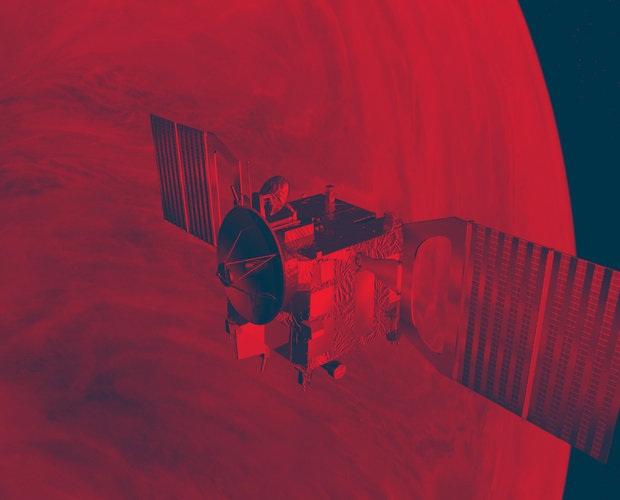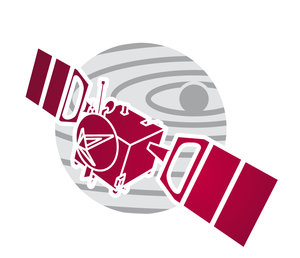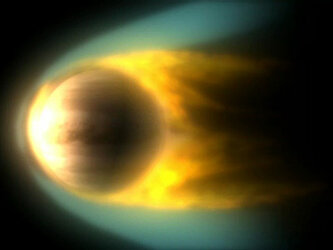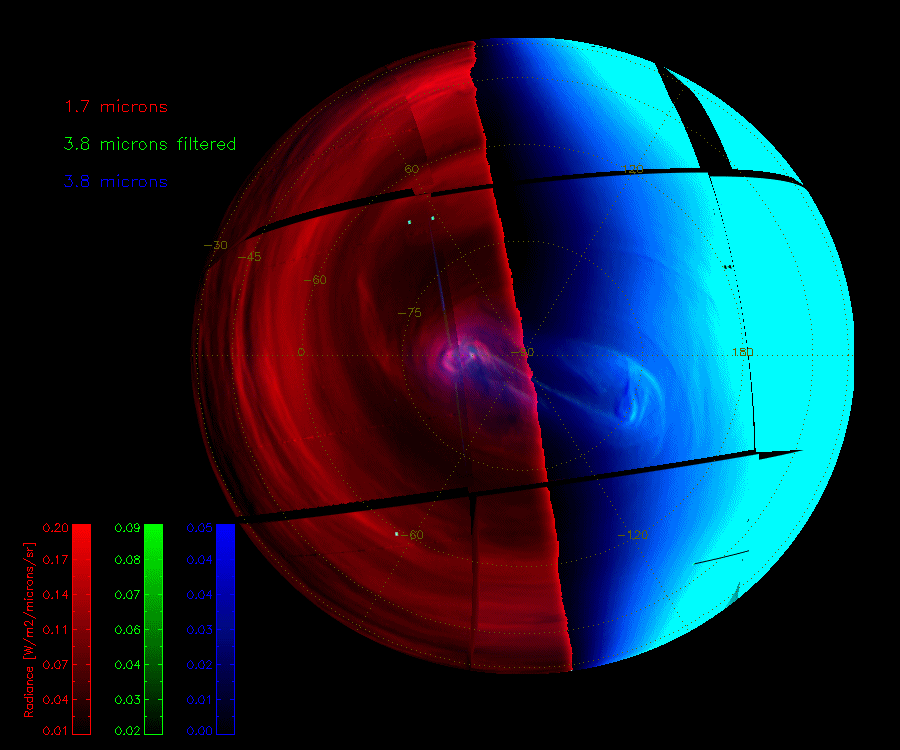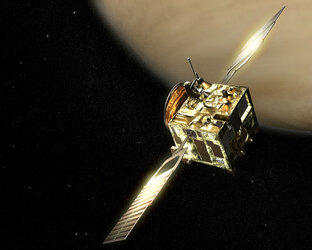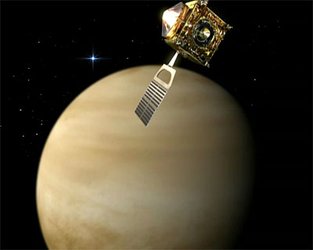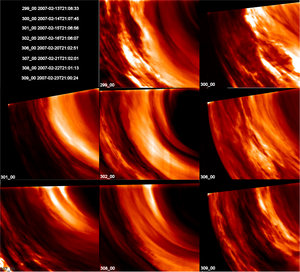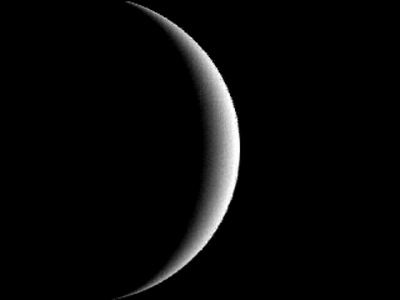Venus: Earth’s twin planet?
ESA’s Venus Express has revealed Venus as never before. For the first time, scientists are able to investigate from the top of its atmosphere, down nearly to the surface. They have shown it to be a planet of surprises that may once have been more Earth-like, and still is, to a certain extent.
The latest results from the mission were presented today at a press conference held at ESA headquarters in Paris, and will appear in the 29 November issue of the scientific journal Nature.
Permanently covered in clouds, Venus has been a mystery for centuries. Although it is the planet nearest to Earth, it has proved extraordinarily difficult to study because of its curtain of clouds that obscures our view of its surface.

“It is really surprising how un-Earth-like Venus is now,” says Fred Taylor, a Venus Express interdisciplinary scientist, University of Oxford, UK. Venus has approximately the same mass as the Earth yet it is a hellish place where surface temperatures are over 400°C and the surface pressure is a hundred times that on Earth.
The key to understanding Venus lies in its atmosphere. It is much thicker than Earth’s and intercepts most of the Sun’s energy before it can reach the surface. That’s where Venus Express comes in.
“Today’s results focus on the different science themes Venus Express is covering,” says Dmitri Titov, Venus Express science coordinator from the Max-Planck-Institute for Solar System Research, Germany. “An important first set of results concerns the complex dynamics and structure of Venus’s atmosphere, studied with a whole suite of instruments.”

Titov added, “The spacecraft has revealed the structure and movements of the atmosphere, from its upper reaches to just above the surface, and has obtained the best global map of atmospheric temperatures to date. This is already improving our understanding of the global dynamics and the meteorology of Venus.”
“It is worthwhile mentioning the amazing 3D images of the south polar vortex, the fine details of clouds some very Earth-like and hazes, precise wind measurements, and the nicest views ever of the phenomena that make Venus glow in space at infrared wavelengths,” added Håkan Svedhem, ESA’s project scientist for Venus Express.
A second set of results concerns both the atmosphere’s composition and its chemistry. Venus Express has taken compositional profiles of the atmosphere around the planet, and unambiguously confirmed the presence of lightning which can have a strong effect on the composition of the atmosphere itself.
The challenge for scientists now is to match those readings of the atmosphere’s composition with known gases, because they behave differently in the extraordinarily high-pressure environment on Venus than they do on Earth or Mars. “We are only at the beginning of this work,” says Titov, “but we know new surprises are waiting for us.”

A third set of results is about the processes by which the atmosphere of Venus is escaping into space. This is driven by the solar wind – a stream of electrically charged particles given out by the Sun. As the solar particles collide with electrically charged particles near Venus, they energise the gas, stripping it forever from the planet.
Venus Express has provided giant leaps in the understanding of all these phenomena, and found how Venus loses water due its interaction with the solar wind. New measurements of heavy water in the atmosphere are also providing new clues on the history of water on the planet and its overall climate evolution.
However, not all mysteries are solved yet. One key answer that scientists would still like to know is just how active the volcanoes of Venus are. “The contribution of volcanoes to the atmosphere could be enormous. Not knowing leaves a huge hole in our understanding of the climate,” says Taylor.
For a planet that was once thought to resemble Earth, to one that was thought to be completely dissimilar, the tables have turned again. Thanks to Venus Express, Taylor now describes Venus as “Earth’s twin, but separated at birth.”
Notes for editors:
Venus Express has now completed its nominal mission. This involved watching the planet for two venusian days, which, because Venus rotates so slowly, lasted approximately 500 Earth days.
Venus Express will now start its extended mission to watch the planet for two more venusian days. One of the things that it will be doing is to look for the telltale infrared radiation from lava flows, but the analysis is proving difficult. In 2010, a Japanese mission, Venus Climate Orbiter also called Planet-C, will arrive at Venus and this will allow scientists to compare results from the two spacecraft.
More than 250 scientists and engineers across Europe are involved in the Venus Express mission, supported by their institutes and national space agencies. The mission also sees the contribution of scientists from Russia and Japan, as well as from NASA, which sponsors 15 American Venus Express scientists and provides support to the radio science investigation via its Deep Space Network antennas.
The contents of this article are reflected in ‘Venus as a more Earth-like planet’, to be published in tomorrow’s issue of Nature. The paper is by H. Svedhem, D. Titov, F. Taylor and O. Witasse.
The latest Venus Express results that will all appear in the 29 November 2007 issue of Nature are as follows:
- ‘A warm layer in Venus’ cryosphere and high-altitude measurements of HF, HCl, H2O and HDO’ by J.-L. Bertaux, A.-C. Vandaeleat al.
- ‘The structure of Venus’ middle atmosphere and Ionosphere’ by M. Pätzold, B. Häusler et al.
- ‘South-polar features on Venus similar to those near the north pole’ by G. Piccioni, P. Drossart et al.
- ‘Morphology and dynamics of the upper cloud layer of Venus’ by W. Markiewicz, D. Titov et al.
- ‘A dynamic upper atmosphere of Venus as revealed by VIRTIS on Venus Express’ P. Drossart, G. Piccioni et al.
- ‘Venus loses its water through the plasma wake’ by S. Barabash, A. Fedorov et al. ‘Little or no solar wind enters Venus’ atmosphere at solar minimum’ by T. Zhang, M. Delva, et al.
- ‘Lightning on Venus inferred from whistler-mode waves in the ionosphere’ by C. Russell, T. Zhang et al.
For more information:
Håkan Svedhem, ESA’s Venus Express Project Scientist
Email: Hakan.Svedhem @ esa.int
Fred Taylor, Venus Express interdisciplinary scientist, University of Oxford, UK
Email: Fwt @ atm.ox.ac.uk
Dmitri Titov, Venus Express science coordinator, Max-Planck-Institute for Solar System Research, Germany
Email: Titov @ mps.mpg.de















 Germany
Germany
 Austria
Austria
 Belgium
Belgium
 Denmark
Denmark
 Spain
Spain
 Estonia
Estonia
 Finland
Finland
 France
France
 Greece
Greece
 Hungary
Hungary
 Ireland
Ireland
 Italy
Italy
 Luxembourg
Luxembourg
 Norway
Norway
 The Netherlands
The Netherlands
 Poland
Poland
 Portugal
Portugal
 Czechia
Czechia
 Romania
Romania
 United Kingdom
United Kingdom
 Slovenia
Slovenia
 Sweden
Sweden
 Switzerland
Switzerland



























